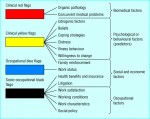 I just received a notice from The Week in Chiropractic (a weekly e-mailed newsletter from the FCER, Foundation for Chiropractic Education and Research) about imaging guidelines for chiropractic. Read all about this Web-based consultation, below. See also Practice Guidelines
I just received a notice from The Week in Chiropractic (a weekly e-mailed newsletter from the FCER, Foundation for Chiropractic Education and Research) about imaging guidelines for chiropractic. Read all about this Web-based consultation, below. See also Practice Guidelines
Between August 1st and October 31st, 2006, a Web site will be made available for chiropractors to evaluate new imaging guidelines on neuromusculoskeletal disorders in adults. Participants will be asked to provide comments and suggestions regarding various characteristics of the proposed imaging guidelines. Specific characteristics include ease of use; feasibility and desire of implementing these guidelines in practice; how comprehensive are each of the recommendations; corresponding comments . . .
There is an urgent need throughout the health care professions to develop practice guidelines. The purpose of this project is to develop evidence-based diagnostic imaging practice guidelines for neuromusculoskeletal disorders for use by chiropractors. The project consists of eight phases, four of which have already been completed. Based on an exhaustive literature review, and in collaboration with a staff chiropractic radiologist, a first draft of diagnostic imaging practice guidelines for chiropractic was produced and then sent for a first external review (phase 3). A group of over 70 international experts on the topic of neuromusculoskeletal disorders have evaluated the proposed guidelines to provide recommendations by consensus opinion (phase 4). The expert consensus guidelines will then be forwarded to various chiropractic specialties for further external review and consideration (phase 5). Simultaneously, a ‘’public’’ website will be made available for worldwide chiropractors to consider the Delphi expert consensus guidelines (phase 6). Upon completion of the second external review and after receiving comments by field practitioners about the ‘’public’’ website, the suggestions and comments will be considered by the executive committee and incorporated into the document for the Delphi expert panel to review (phase 7). The executive committee will then draft the final version of the guidelines based on consensus opinion. Phase 8 of this project will involve the dissemination and implementation of the international consensus opinion guidelines.
Diagnostic imaging practice guidelines are intended to reduce unnecessary radiation exposure, increase examination precision and decrease health care costs–all without compromising the quality of care.
Researchers:
André E. Bussières, DC, FCCS (C), BSc (Professor, Chiropractic Department, Université du Québec à Trois-Rivières)
Cynthia Peterson DC, RN, M.Med.Ed, DACBR, (Professor, Canadian Memorial Chiropractic College)
John A. M. Taylor DC, DACBR (Professor of Radiology, New York Chiropractic College)
Correspondence: Bussières, André, Département Chiropratique, Université du Québec à Trois-Rivières (UQTR), C.P. 500, Trois-Rivières, Québec, Canada G9A 5H7. andre.bussieres@uqtr.ca
Filed under: Chiropractic/CAM, Evidence Based Health Care, Practice Guidelines | 1 Comment »
 Every year an important meeting for medical educators and researchers to attend is the RIME meeting, which forms part of the American Association of Medical Colleges Annual Meeting. [Here is the AAMC program by sponsor.]
Every year an important meeting for medical educators and researchers to attend is the RIME meeting, which forms part of the American Association of Medical Colleges Annual Meeting. [Here is the AAMC program by sponsor.]









 The following literature review was published in the August 15, 2006 issue of Spine: [available by subscription only]
The following literature review was published in the August 15, 2006 issue of Spine: [available by subscription only] Dr. Hans Baer of the University of Melbourne has published another article on legitimation, this time in Social Science & Medicine. See also
Dr. Hans Baer of the University of Melbourne has published another article on legitimation, this time in Social Science & Medicine. See also  Just published in the September 2006 issue of Physical Therapy:
Just published in the September 2006 issue of Physical Therapy: This article was just published in Complementary Health Practice Review:
This article was just published in Complementary Health Practice Review: If you use PubMed a lot, this new feature may be of great interest to you. You can now customize the display of citations retrieved by using a new feature in
If you use PubMed a lot, this new feature may be of great interest to you. You can now customize the display of citations retrieved by using a new feature in